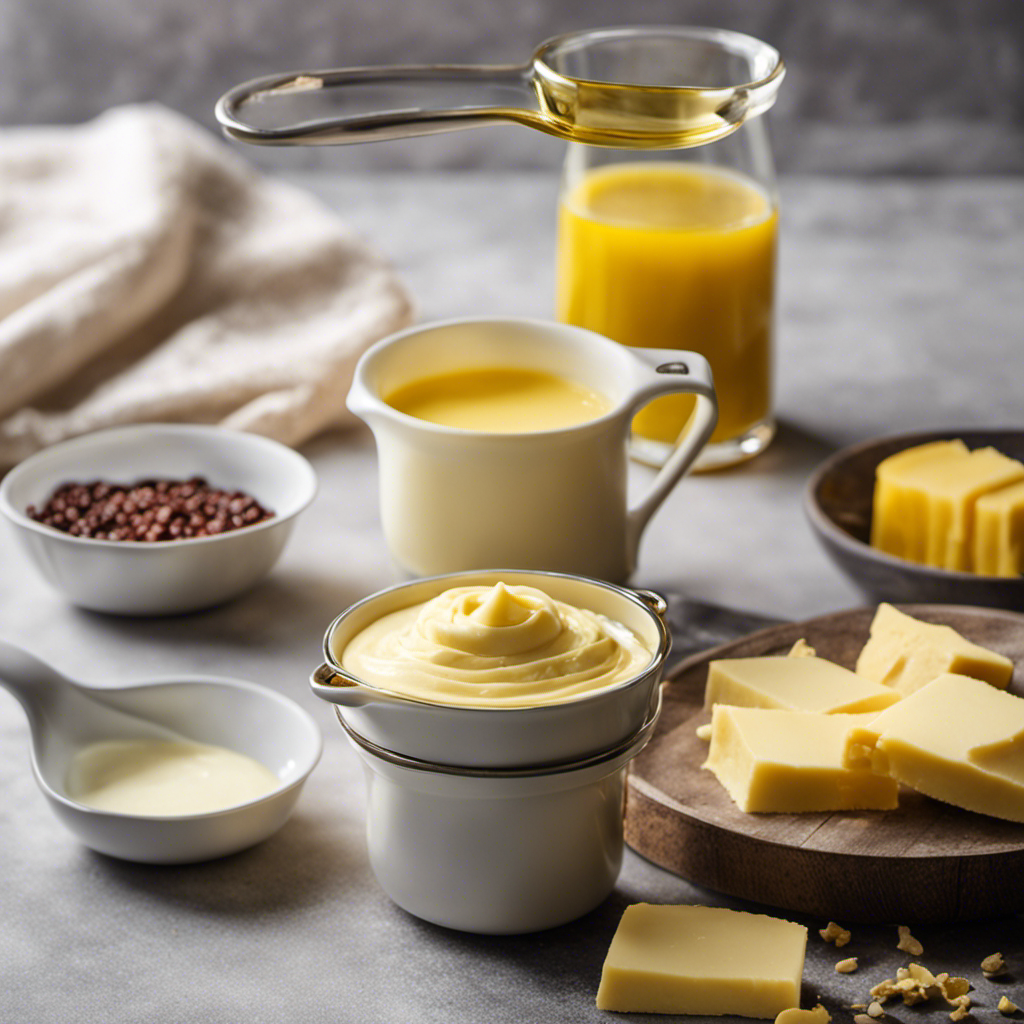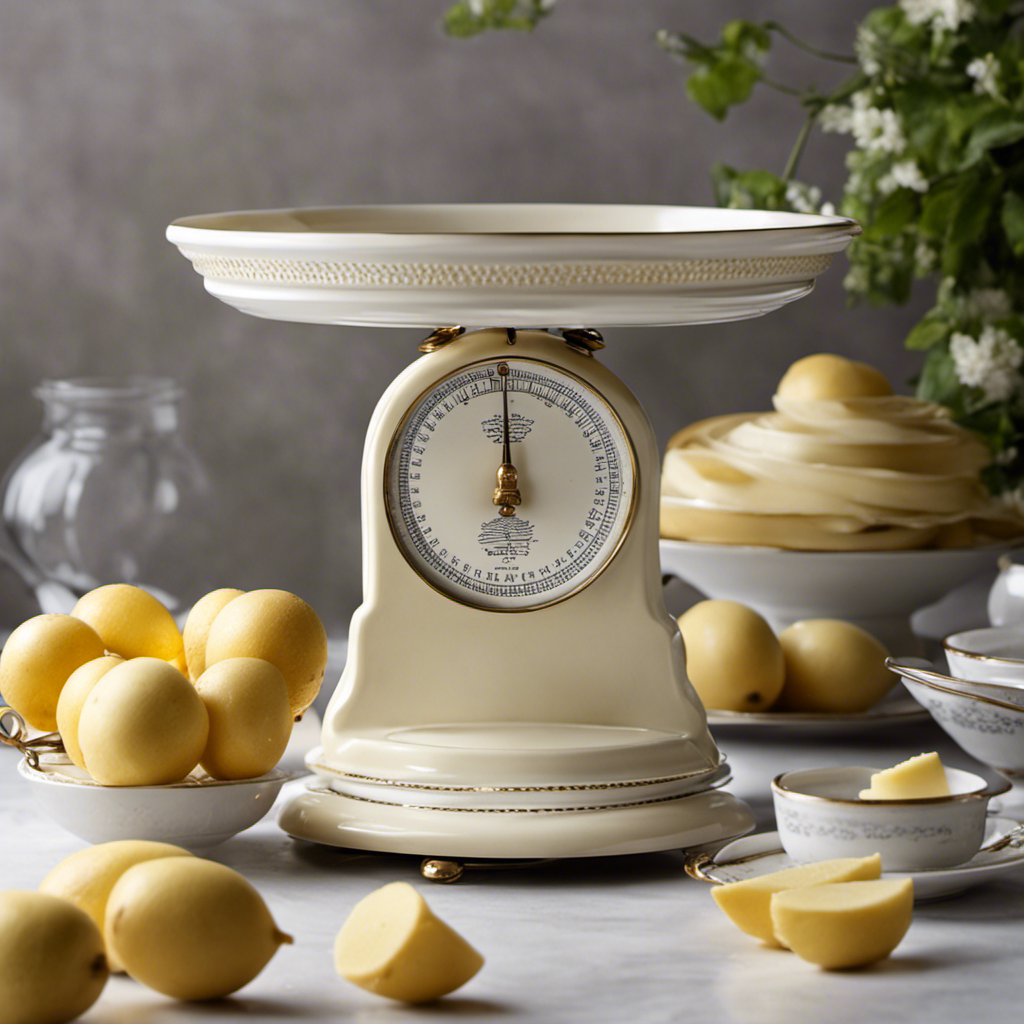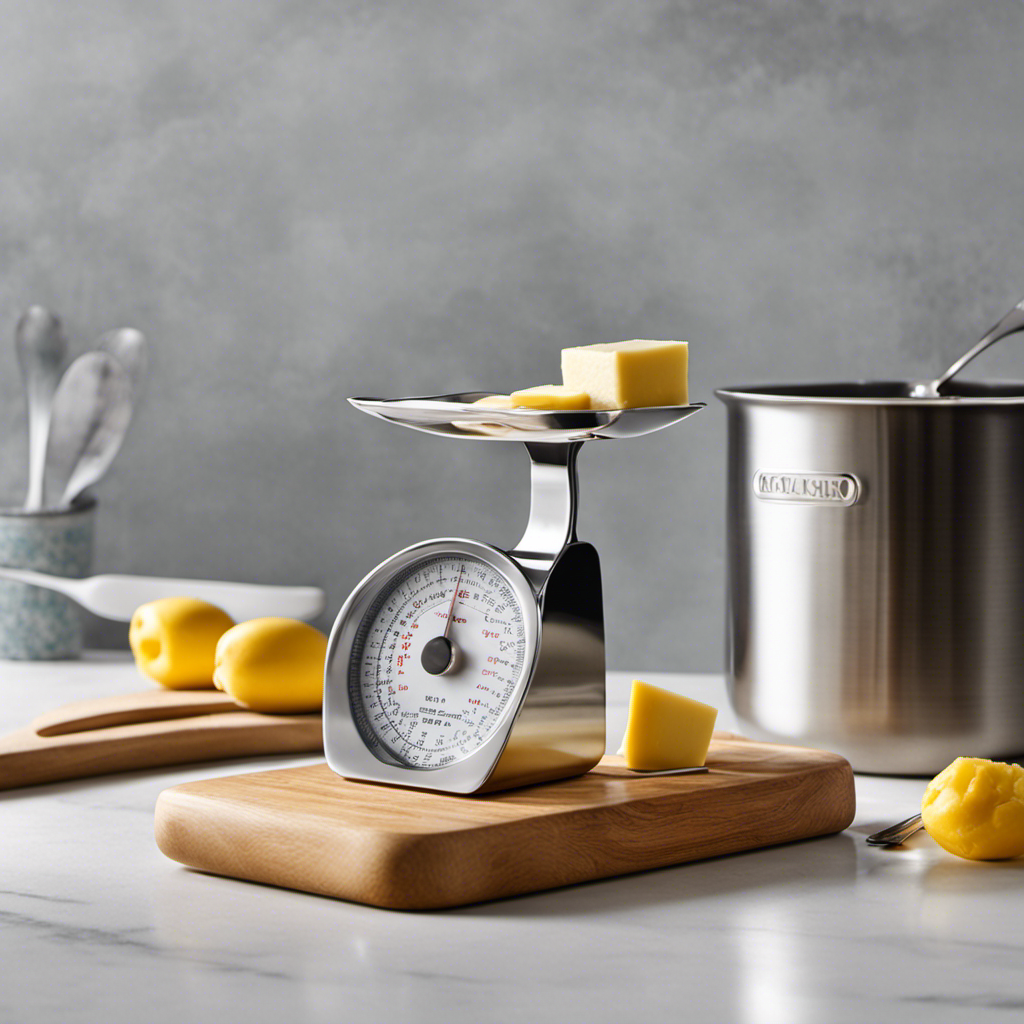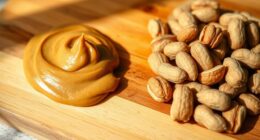As an enthusiastic amateur chef, I frequently find myself in the kitchen, confronted with the challenge of determining the right amount of butter to substitute when a recipe demands 1/2 cup of oil. It feels like a quest to strike the ideal equilibrium of richness and being mindful of health.
In this article, we’ll dive into the conversion ratio, explore the pros and cons of butter and oil, and uncover the secrets to substituting one for the other in recipes. Get ready to unlock the mysteries of butter and oil in your culinary adventures.
Key Takeaways
- The conversion ratio for butter to oil is 1 cup of butter to 1/2 cup of oil.
- Transitioning from butter to oil can provide various health benefits, as butter is high in saturated fat which can increase the risk of heart disease.
- Unsaturated fats found in oils, such as olive oil, can help lower LDL cholesterol levels and promote heart health.
- When substituting butter with oil in baking, it is important to consider factors such as flavor, smoke point, and nutritional benefits of different oils, as well as the potential impact on taste and texture of the final product.
Understanding the Conversion Ratio
The conversion ratio for butter to oil is 1 cup of butter to 1/2 cup of oil.
When it comes to nutritional benefits, butter contains essential vitamins like A, D, and E, as well as cholesterol. However, it is also high in saturated fat, which can increase the risk of heart disease.
On the other hand, oil, such as olive oil, is rich in monounsaturated fats, which can help lower bad cholesterol levels and reduce the risk of heart disease. Additionally, oils like olive oil contain antioxidants and anti-inflammatory properties that provide various health benefits.
While butter may offer some nutritional benefits, its high saturated fat content poses health risks.
Transitioning to the next section, we will now explore the question of which is healthier: butter or oil.
Butter Vs. Oil: Which Is Healthier
When comparing the nutritional value of butter and oil, it is important to consider their respective levels of fats, vitamins, and minerals.
Additionally, the impact on cholesterol levels is a crucial factor to examine, as butter is known to be high in saturated fats which can raise LDL cholesterol.
Understanding the cooking applications and benefits of each can help inform healthier choices in the kitchen and promote overall well-being.
Nutritional Value Comparison
Comparing the nutritional value, 1/2 cup of oil contains more fat than butter. Understanding the nutritional benefits and the impact on heart health is crucial when making dietary choices. Let’s take a closer look at the nutritional values of both oil and butter:
| Nutrient | 1/2 Cup of Oil | 1/2 Cup of Butter |
|---|---|---|
| Fat (g) | 96 | 81 |
| Cholesterol (mg) | 0 | 244 |
| Vitamin A (IU) | 0 | 1,860 |
As we can see from the table, oil contains a higher amount of fat compared to butter. However, butter contains more cholesterol and vitamin A than oil. It is important to note that excessive consumption of saturated fats, like those found in butter, can increase the risk of heart disease. On the other hand, vegetable oils, like olive oil, are rich in heart-healthy monounsaturated fats. Therefore, when considering the impact on heart health, it is advisable to choose oils over butter in moderation.
Impact on Cholesterol Levels
If you’re concerned about your cholesterol levels, it’s important to consider the impact of different fats in your diet.
Saturated fats, found in foods like butter and animal fats, can raise your LDL cholesterol levels, which can increase the risk of heart disease.
On the other hand, unsaturated fats, such as those found in vegetable oils, can help lower LDL cholesterol levels and improve heart health.
When choosing fats for cooking or baking, it’s best to opt for healthier options like olive oil or avocado oil. These oils not only provide a rich flavor but also offer numerous health benefits.
Incorporating these healthier fats into your diet can have a positive impact on your cholesterol levels and overall heart health.
In the next section, we will explore their cooking applications and benefits.
Cooking Applications and Benefits
Incorporating healthier fats like olive oil or avocado oil into your cooking can not only enhance the flavor of your dishes but also provide numerous health benefits. When comparing butter and margarine, it’s important to note that butter is a natural product made from cream, while margarine is a processed product made from vegetable oils.
Butter contains a higher percentage of saturated fat, which can increase cholesterol levels. On the other hand, olive oil and avocado oil are rich in monounsaturated fats, which can help improve heart health. Additionally, these oils are packed with antioxidants and anti-inflammatory properties.
By using these healthier oils in your cooking, you can enjoy the benefits of a more balanced fat intake and reduce the risk of heart disease.
Transitioning into the subsequent section about ‘baking with butter: tips and tricks’, it’s important to understand the differences and benefits of using butter in baking.
Baking With Butter: Tips and Tricks
To achieve a richer flavor in your baked goods, try using butter instead of oil. Butter substitution in baking can have a significant impact on the taste and texture of your creations.
Here are three tips and tricks to consider when baking with butter:
-
Use unsalted butter: By using unsalted butter, you have more control over the salt content in your recipe. This is especially important when baking delicate pastries or cakes.
-
Adjust the quantity: When substituting butter for oil, keep in mind that 1 cup of oil is equivalent to 1 cup of melted butter. However, if your recipe calls for a specific measurement, such as 1/2 cup of oil, you would need to use 1/2 cup of melted butter.
-
Consider the water content: Butter contains water, so when substituting it for oil, you may need to adjust the other liquids in your recipe slightly. This will help ensure the right consistency in your baked goods.
Incorporating butter instead of oil in your baking can add a rich and indulgent flavor that elevates your creations to the next level.
Cooking With Oil: Pros and Cons
When it comes to cooking with oil, there are several key points to consider.
First, the health benefits of different oils can vary significantly. Certain oils, such as olive oil, have been shown to have numerous health benefits, including reducing inflammation and improving heart health.
Second, different oils can have distinct taste and texture differences, which can greatly impact the flavor and texture of your dishes.
Lastly, it’s important to consider the smoke point of oils, as heating an oil past its smoke point can lead to the formation of harmful compounds and a burnt taste in your food.
Health Benefits of Oil
The health benefits of oil include reducing inflammation and improving heart health.
-
Rich in Unsaturated Fats: Cooking oils, such as olive oil and avocado oil, are high in monounsaturated and polyunsaturated fats. These fats have been shown to lower bad cholesterol levels and reduce the risk of heart disease.
-
Source of Antioxidants: Some oils, such as coconut oil and sesame oil, contain antioxidants that help fight inflammation in the body. These antioxidants can protect against chronic diseases like arthritis and certain types of cancer.
-
Essential Vitamins and Nutrients: Different types of cooking oils provide various essential vitamins and nutrients. For instance, sunflower oil contains vitamin E, which is known for its antioxidant properties and skin health benefits.
In addition to their health benefits, cooking oils also contribute to the taste and texture of dishes.
Taste and Texture Differences
You’ll notice a distinct difference in taste and texture when using different types of cooking oils in your dishes. When comparing butter to margarine, for example, butter has a rich, creamy flavor and a smooth, velvety texture. Margarine, on the other hand, often has a milder taste and a slightly greasy mouthfeel.
Butter is also known for its health benefits, as it contains important nutrients like vitamins A, D, and E, as well as fatty acids that support brain function and boost immunity. However, it’s important to consider the smoke point of the oil you’re using, as different oils have different temperatures at which they start to smoke and break down.
This can affect the taste and quality of your dish.
Smoke Point Considerations
Consider using oils with a higher smoke point, as they are less likely to burn and affect the taste of your dish.
When it comes to cooking, the smoke point of an oil is an important factor to consider. The smoke point refers to the temperature at which the oil begins to break down and produce smoke. Different oils have different smoke points, and this can greatly impact their cooking applications and benefits.
Here are three key considerations regarding smoke points:
-
Cooking applications: Oils with higher smoke points, such as avocado oil or refined safflower oil, are ideal for high-heat cooking methods like frying or sautéing. They can withstand the high temperatures without burning and maintain their integrity.
-
Flavor preservation: Using an oil with a smoke point appropriate for the cooking method helps preserve the flavor of the dish. When an oil burns, it can impart a bitter or unpleasant taste to the food.
-
Health benefits: Oils with higher smoke points are often more stable and contain higher levels of beneficial compounds like vitamin E and antioxidants. By choosing oils with higher smoke points, you can enhance the nutritional value of your dishes.
How to Substitute Butter With Oil in Recipes
When substituting butter with oil in recipes, it’s important to know how much butter is equivalent to 1/2 cup of oil.
Butter and margarine have different pros and cons. Butter is a natural and unprocessed product, while margarine is made from vegetable oils that undergo a hydrogenation process.
Butter contains essential nutrients like vitamins A, D, and E, as well as healthy fats. It also adds flavor and richness to recipes. However, butter is high in saturated fats and cholesterol, which can be harmful to heart health.
On the other hand, using oil as a substitute for butter can reduce the saturated fat content in recipes. It’s important to note that different oils have different flavors, smoke points, and nutritional profiles.
For example, olive oil is rich in monounsaturated fats and has a low smoke point, making it ideal for sautéing and low-heat cooking.
Overall, when substituting butter with oil, consider the flavor, smoke point, and nutritional benefits of different oils to find the best option for your recipe.
Adjusting Recipes: Butter to Oil Conversion
When it comes to substituting butter with oil in recipes, the taste can be a crucial factor to consider. While butter imparts a rich and creamy flavor, oil tends to have a more neutral taste. Therefore, understanding the differences in taste between butter and oil can help in making an informed decision when converting a recipe.
To ensure an accurate conversion, there are a few tips that can be followed. One tip is to use a conversion chart or measuring by weight rather than volume. These methods can help in getting the right amount of oil to substitute for butter.
Butter Vs. Oil Taste
You can taste the difference between butter and oil when using them in cooking. The choice between butter and oil depends on the specific dish you are preparing.
Here are some key differences between butter and oil in savory dishes and desserts:
-
Butter in savory dishes:
-
Adds richness and depth of flavor
-
Enhances the taste of ingredients
-
Creates a creamy texture
-
Oil in savory dishes:
-
Provides a neutral flavor
-
Allows other ingredients to shine
-
Helps achieve a crisp texture
-
Butter in desserts:
-
Imparts a luxurious, buttery taste
-
Adds moisture and richness
-
Enhances the overall flavor profile
-
Oil in desserts:
-
Creates a lighter texture
-
Adds a subtle, neutral taste
-
Helps retain moisture
Understanding these differences will help you choose the right ingredient for your desired outcome in both savory dishes and desserts.
Tips for Accurate Conversion?
Converting recipes can be a tricky task, especially when it comes to accurately measuring ingredients. To ensure precision, here are some tips for accurate conversion.
Firstly, it’s essential to have reliable measuring tools. Invest in a good set of measuring cups and spoons, preferably those with clear markings and accurate measurements.
Secondly, always follow the recipe’s conversion guidelines. If a recipe calls for 1/2 cup of oil, use the appropriate conversion ratio to determine the amount of butter needed. This can be found in conversion charts or online resources.
Additionally, consider the texture and consistency of the ingredients. Butter and oil have different properties, so conversions may not always be a one-to-one ratio. Adjustments may be necessary to achieve the desired result.
Lastly, practice and experimentation are key. By testing out different conversions and noting the outcomes, you can develop a better understanding of how ingredients interact and how to achieve accurate measurements in your recipes.
Achieving the Same Flavor With Oil
Achieving the same flavor with oil is possible by adding spices and seasonings to enhance the taste. When substituting oil for butter in a recipe, it’s important to make adjustments to ensure the desired flavor is achieved. Here are three ways to accomplish this:
-
Increase the amount of spices and seasonings used in the recipe. Since butter has a rich and creamy flavor, adding more spices can help replicate that taste when using oil.
-
Use flavored oils to add additional depth of flavor. For example, using garlic-infused oil can provide a similar taste to garlic butter.
-
Consider adding a small amount of butter extract or essence to enhance the buttery flavor. This can be a helpful addition when trying to replicate the taste of butter in baked goods.
Texture and Consistency: Butter Vs. Oil
When substituting butter with oil in a recipe, the texture and consistency of the final dish may be slightly different.
Butter and oil have different compositions, which can affect the outcome of baked goods. Butter contains water, milk solids, and fat, whereas oil is purely fat.
The water content in butter contributes to the tender and moist texture in baked goods, while the fat content provides flavor and richness.
When using oil instead of butter, the absence of water can result in a slightly drier texture. However, oil can still provide moisture and tenderness to baked goods.
It is important to note that the type of oil used can also impact the final texture and consistency. For example, vegetable oil tends to produce a lighter and more tender texture compared to other oils.
Butter and Oil in Different Culinary Traditions
In my previous discussion on the texture and consistency of butter versus oil in baking, I highlighted the different outcomes that these ingredients can yield. Now, let’s delve into the cultural differences in the usage of butter and oil in various culinary traditions.
In Mediterranean cuisine, olive oil is a staple ingredient, used for everything from sautéing vegetables to dressing salads.
In French baking, butter is highly revered and cherished for its rich flavor and ability to create flaky pastries.
In Indian cooking, ghee, a clarified butter, is commonly used for its nutty aroma and ability to withstand high temperatures.
These cultural variations reflect the diverse culinary practices around the world, demonstrating how butter and oil play distinct roles in different cuisines.
Understanding these differences can enhance our appreciation for the art of cooking and inspire us to explore new flavors and techniques.
Butter and Oil: Cost Comparison
The cost of butter and oil varies significantly based on the brand and quality. A cost analysis reveals that butter tends to be more expensive than most oils. For example, a pound of butter can cost around $5, whereas a bottle of vegetable oil of the same weight may cost only $3.
This price difference can have implications for individuals and families who rely on butter for cooking and baking. While butter is often preferred for its rich flavor and texture, using oil as an alternative can be a more economical choice. Moreover, considering the health implications, some oils like olive oil or avocado oil offer additional benefits, such as being high in monounsaturated fats.
Exploring alternative oil options beyond butter can therefore provide both cost savings and potential health advantages.
Exploring Alternative Oil Options: Beyond Butter
If you’re looking to explore alternatives beyond butter, you might consider trying oils like olive oil or avocado oil for both cost savings and potential health benefits. These oils offer a range of culinary uses and can be a healthier option compared to butter.
Here are three oils to consider:
-
Olive oil: With its rich flavor and versatility, olive oil is a popular choice in many cuisines. It contains monounsaturated fats, which can help reduce bad cholesterol levels and lower the risk of heart disease.
-
Avocado oil: This oil has a high smoke point, making it suitable for high-heat cooking methods like frying and grilling. It is also rich in monounsaturated fats and vitamin E, which are beneficial for heart health.
-
Coconut oil: Known for its distinct flavor and aroma, coconut oil is widely used in baking and cooking. It contains medium-chain triglycerides, which are easily metabolized and can provide a quick source of energy.
Frequently Asked Questions
Can I Use Margarine Instead of Butter When Substituting With Oil in Recipes?
Yes, you can use margarine instead of butter when substituting with oil in recipes. However, it is important to note that the taste and texture may vary. It is also possible to use other types of oil instead of butter when converting measurements.
How Does Using Oil Instead of Butter Affect the Texture of Baked Goods?
Using oil instead of butter can affect the texture of baked goods. It tends to make them moister and denser. However, the flavor impact can vary depending on the type of oil used.
Are There Any Health Benefits to Using Butter Instead of Oil in Cooking?
There are no significant health benefits to using butter instead of oil in cooking. In fact, butter contains more saturated fat which can increase the risk of heart disease. However, some people may prefer the taste of butter in certain recipes.
Can I Use Coconut Oil Instead of Butter When Converting Measurements?
I prefer using coconut oil instead of butter when baking. It has a unique flavor and adds moisture to my recipes. However, it’s important to note that coconut oil has a higher fat content compared to butter.
Are There Any Specific Recipes Where Substituting Oil for Butter Is Not Recommended?
Substituting oil for butter can alter the flavor of dishes. It’s important to consider cultural or regional cuisines where oil is traditionally preferred over butter. However, without the context of specific recipes, it’s difficult to provide a definitive answer.
Conclusion
In conclusion, after delving into the world of butter and oil, it is clear that they each have their own unique characteristics and uses.
While butter adds richness and flavor to baked goods, oil provides a lighter texture.
When it comes to health, moderation is key and it’s important to consider the specific needs of your body.
So next time you’re in the kitchen, whether you choose the creamy indulgence of butter or the versatility of oil, remember that cooking is like a symphony, where the right ingredients create a harmonious masterpiece.










